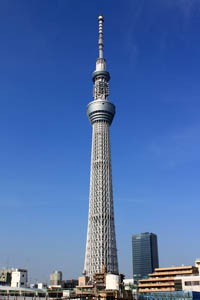Tower Talk: Hands-on Materials Science and Engineering
Families and young engineers can get hands on exploring the ins and outs of tower building using LEGO®, spaghetti, or even newspaper. Have fun seeing who can build the tallest tower, but be prepared for some structural collapses along the way as they explore what works—and what doesn't.

The Skytree Tower in Japan, shown above, is currently the tallest tower in the world and ranks third on the list of tallest structures in the world. Exploring tower construction with everyday materials or toys lets young builders learn more about engineering principles. A giant tower built from LEGO or pasta might come crashing to the ground, but that's sometimes half the fun! (Image: Kakidai, Wikipedia)
The Tallest of Tall
A timeline of tallest towers, buildings, and structures chronicles a history of taller and taller structures as engineers conquer structural challenges and develop new ways to make materials like steel and concrete reach even higher. Today, the Tokyo Skytree, standing 2,080 feet tall, is listed as the tallest non-habitable tower in the world. The Burj Khalifa, a skyscraper in Dubai, holds the title of tallest man-made structure (of any kind) and rises more than 2,700 feet. Just last week, The Shard, a 95-story building in London, was named the tallest structure in Western Europe at 1,016 feet, but its regional claim to fame may be short lived. Already another tower is underway that is projected to out-climb it by year's end. That the Washington Monument stands just a bit more than 555 feet puts the sheer climb of these record-holding structures in vertical perspective. By comparison, Willis Tower (formerly the Sears Tower) in Chicago is the tallest building in the United States. Willis Tower stands 1,451 feet and held the "tallest in the world" title in 1973 and for almost a quarter century after. It lost the title to the Petronas Twin Towers in Kuala Lumpur.
Putting civil engineering to the side, another tower completed this year in South Korea also set a record—the record for the tallest tower built from LEGO blocks. Rising skyward 105 feet, and built by 4,000 children using more than 500,000 bricks, the celebratory tower topped the previous record-holding LEGO tower by inches.
Scaled to Size
Whether real-world towers or LEGO creations, looking at the history of tall structures and at current towers offers important clues about fundamental engineering and materials sciences concepts that go into tower construction. Even toddlers building towers with chunky plastic bricks run into predictable structural problems. Stack too many Duplo® blocks one on top of another, and the tower, ultimately, will begin to lean and fall. Similar issues arise with smaller LEGO bricks, but the greater variety of brick sizes lets kids experiment with more sophisticated structural design as they search for various ways to increase stability to support greater height. The "Building the Tallest Tower" project lets students explore tower construction and the relationship between height and stability—especially in the context of shaking.
Other questions your tower builders might ask and investigate with their tower creations include: Does a tower require a certain shape? Are certain shapes more stable at greater heights? What's the mathematical relationship between the size of the base and a stable height? How do you keep a tower from bending? Why might it bend and at what height? What forces, like wind, does a tower have to withstand?
Beyond Bricks
While brick-based building materials like LEGO offer widespread ground for exploration and innovation, young engineers can also pursue tower construction using other household or toy-based materials and supplies. Building a tower from newspaper, alone, poses a fun challenge in problem solving and creative thinking. Add a bit of tape or glue in the process, and see how much taller the structure can rise.
For something completely different, bring out the pasta and challenge your builders to see what kind of tower they can construct using uncooked spaghetti noodles and Emer's® glue. The "The Leaning Tower of Pasta" project can help you get started. While the project offers a procedure older students can use for a school assignment or science fair, parents can use the general information as a guideline for a fun family science activity. Bring out the glue and pasta! Make sure you have plenty of pasta on hand, and encourage an exploration of noodle length as part of the investigation. Other building materials you and your students might try include toothpicks, popsicle sticks, straws, or even sugar cubes.
How high can you go?
Categories:
You Might Also Enjoy These Related Posts:
- 15 STEM Gifts & Science Kits You'll Feel Good About Giving
- 13 Boat Science and Submarine Science Projects and Experiments
- July 4th STEM! Summer Science Picks for Independence Day!
- 12 Science Kits for Summer Science Experiments and Discovery
- 15 Science Projects to Make and Give for Father's Day
- Ready, Set, Go! (Awesome Summer Science Experiments)
- Awesome Summer Science Experiments
- 10 STEM Activities with Cardboard Tubes









